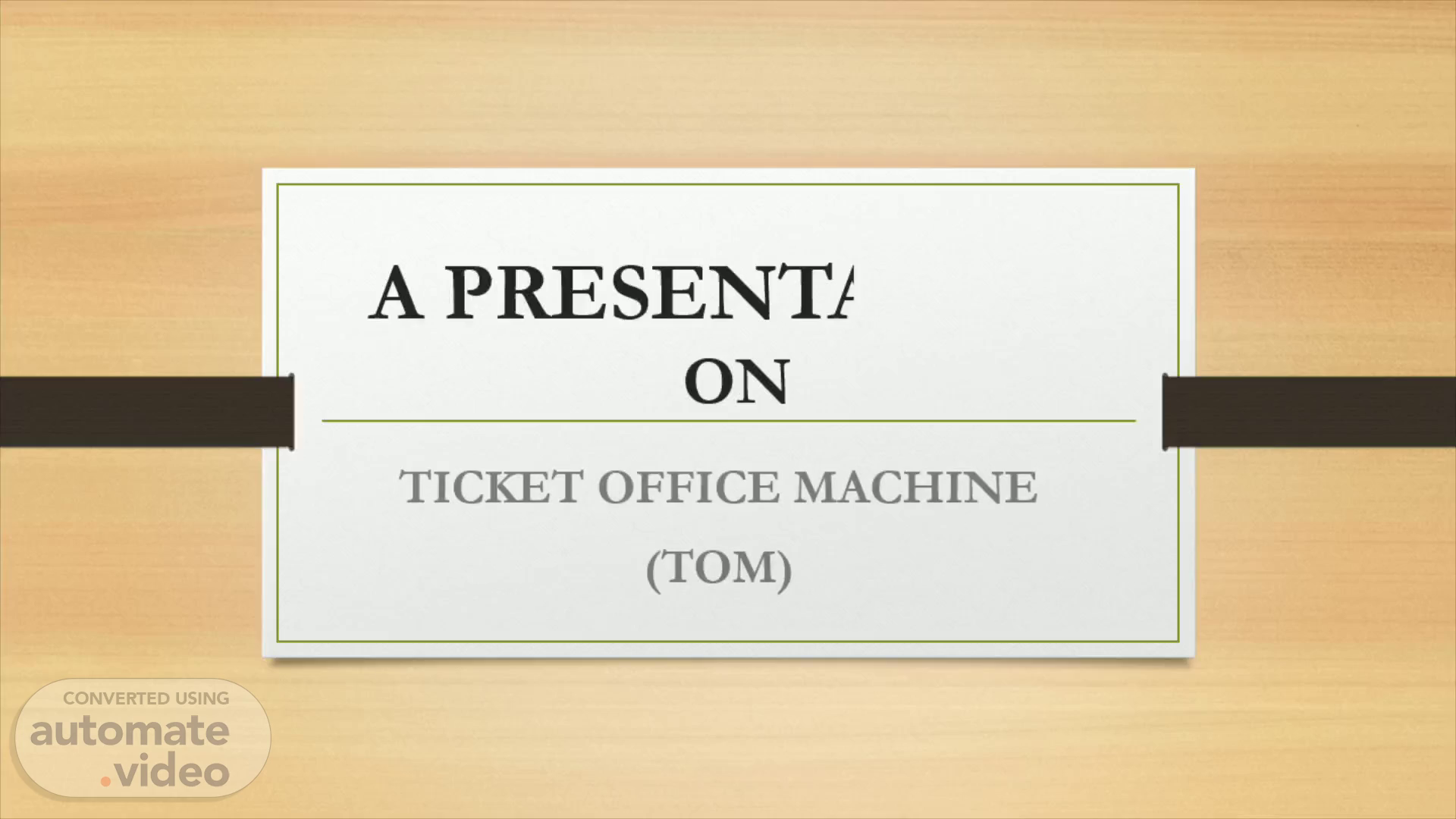Scene 1 (0s)
A PRESENTATION ON. TICKET OFFICE MACHINE (TOM).
Scene 2 (6s)
CONTENTS Definition Basic Function of TOM/EFO System Architecture (1) Hardware Architecture . (2) Software Architecture Function . General Description TOM/EFO Operation Mode Operation Functions Ticket Processing Functions Interface (1) Sc Interface (2) Ras Interface.
Scene 3 (19s)
Definition. Ticket Office Machine (TOM)/Excess Fare Office (EFO) is a machine in function with a booking office clerk mainly to issue tickets to customers in free area, and adjust tickets that are rejected by the gates in paid area..
Scene 4 (32s)
Basic Functions of TOM/EFO. The functions of TOM/EFO are able to enable or disable by downloadable parameters, the functions are as below: Token issue . Card sale Add value . Ticket analysis . Ticket adjustment . Cancellation . Ticket refund Transaction inquiry.
Scene 5 (48s)
System Architecture. 1. Hardware Architecture Ticket Office Machine (TOM)/Excess Fare Office (EFO) will be composed of the following units: Main PC . Touch Screen Monitor . Passenger Information Display(PID) . Ticket Dispending Mechanism(TDM) . Card Reader/Writer . POS Terminal . Receipt Printer . AC/DC Power.
Scene 9 (1m 20s)
2. Software Architecture. Software architecture for this equipment is shown as follows and this structure is almost same as other equipments..
Scene 10 (1m 34s)
Process Architecture.
Scene 11 (1m 40s)
This function describes processes of which are composed to TOM/EFO. Each process is a communication with the event procedure. Main Process: Main part of the TOM/EFO. Based on business logic, this process controls ticket issuing, add value, adjustment, refund replacement, cancellation and various operational process for operator service. Sub process: PID API: PID process is to control PID communication. . TDM API: TDM process is to control TDM communication. Card R/W API: Card R/W process is to control Card R/W communication. . POS API: POS process is to control POS terminal communication. . Printer API: This is process to control Printer communication. . Maint. Process: This process performs maintenance operation of TOM/EFO. SC Process: SC is sub-processes of the TOM/EFO to receive parameter to operate TOM/EFO from SC, to send operation result to SC. TOM/EFO can detect error with diagnostic each internal modules. The result of diagnostic is classified by code. If the result is critical, it uploads to SC by SC process. TOM/EFO send request of refund or replacement to the SC, SC respond to the TOM/EFO..
Scene 12 (2m 32s)
Function General Description . TOM/EFO is normally operated by Metro staff and installed in station ticketing office. TOM/EFO is capable of processing token and stored value card sale. Operator is able to analyze, add value, adjust, replace, refund, extend date, and cancel, also to inquire transaction..
Scene 13 (3m 16s)
TOM/EFO Operation Mode Operation mode Normal TOM/EFO using Mode like Ticket selling, Ticket analysis, Ticket add value, Ticket adjustment, Ticket refund and Cancellation, etc Maintenance mode In maintenance mode, operator can test each module. For example, by choosing PID . test, it tests whether it is normal or abnormal such as LCD Display. Failure mode In case of no SAM in the Card Reader/Writer or failure to communicate with Card Reader/Writer, TOM/EFO cannot change its mode to In Service. In that case, TOM/EFO shows Out of Service Screen and do not operate any of TOM/EFO functions..
Scene 14 (3m 46s)
Operator Functions 1. Stock . The operator can manage CST and CSC stock on this menu. If the CST/CSC quantity is not enough, the operator can replenish CST/CSC on this screen. At the end of operation day, the operator can clear CST in the TDM on this menu. Also, if the failed token quantity is full, the operator can clear failed token on this menu..
Scene 15 (4m 48s)
Ticket Processing Functions . TOM is able to process all types of ticket, it is downloadable parameter to enable or disable processing at TOM for each ticket type. The relevant selling value, purchasing value, and deposit value are downloadable parameters too..
Scene 16 (5m 38s)
5. Ticket Adjustment The operator is able to adjust and surcharge ticket after ticket analysis. Normally EFO has this functionality and passenger is assumed as existing paid area. If the passenger comes from free area, adjustment surcharge will be changed after the operator change operation mode from EFO to TOM..
Scene 17 (6m 20s)
Interface. SC Interface TOM/EFO communicates with SC by using LAN communication. TOM/EFO downloads several files and message from SC, and uploads data and message. If the communications between TOM/EFO and SC is failure, all records uploaded to SC will be stored in TOM/EFOfor seven days. All stored records will be uploaded to SC When the communication between TOM/EFO and SC is recovered..
Scene 18 (6m 45s)
RAS interface 1. Normal Authentication TOM/EFO communicates with RAS by using LAN communication. Before operation log-on, TOM/EFO needs equipment authentication from RAS, to provide the function of ticket selling or add value. If not, TOM/EFO changes to failure mode and can’t be serviced. For authenticate RAS, TOM system transmits following information. Equipment information Authentication code Next flow chart is authentication flow between TOM and RAS..
Scene 19 (7m 10s)
2. OTP Authentication Basically, the remote authentication via communication with RAS is needed before operation logon. That is default operation. Even if there is no network connection, the TOM/EFO can be continuously operated without RAS connection, after RAS OTP authentication. Generally the supervisor can only use the RAS OTP authentication. The procedure for usage of RAS TOP authentication is as follows,.
Scene 20 (7m 34s)
Thank You.
